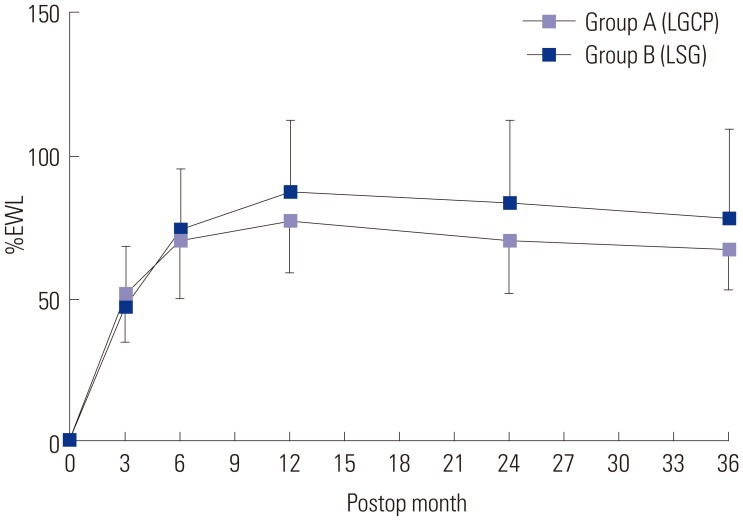Yonsei Med J.
2017 Sep;58(5):1025-1030. 10.3349/ymj.2017.58.5.1025.
Short-Term Outcomes of Laparoscopic Greater Curvature Plication and Laparoscopic Sleeve Gastrectomy in Patients with a Body Mass Index of 30 to 35 kg/m²
- Affiliations
-
- 1Department of Surgery, Gil Medical Center, Gachon University of Medicine and Science, Incheon, Korea. seongmin_kim@gilhospital.com
- KMID: 2418941
- DOI: http://doi.org/10.3349/ymj.2017.58.5.1025
Abstract
- PURPOSE
The aim of this study was the compare the midterm outcomes of laparoscopic greater curvature plication (LGCP) and laparoscopic sleeve gastrectomy (LSG) in obese patients with a body mass index (BMI) of 30 to 35 kg/m².
MATERIALS AND METHODS
This single center, retrospective review of prospectively collected data was conducted for obese patients that underwent LGCP or LSG from March 2013 to February 2016. These two patient groups were compared in terms of demographics, perioperative outcomes, weight loss [percent excess weight loss (%EWL)], comorbidity resolution, and immediate and long-term complications.
RESULTS
A total of 149 patients were eligible for the study. Seventy-five patients underwent LGCP (group A) and 74 LSG (group B). These two groups were matched for age, gender, and baseline BMI. Three patients in each group were readmitted for complications within 30 days postoperatively. %EWL in groups A and B were 51.1±16.9 and 47.8±20.8 at 3 months (p=0.084), 71.1±20.2 and 74.5±21.8 at 6 months (p=0.165), 77.1±18.4 and 87.8±25.1 at 12 months (p=0.002), 70.5±18.5 and 83.4±28.7 at 24 months (p=0.005), and 67.3±15.3 and 78.6±31.7 at 36 months (p=0.054), respectively. Intergroup differences in resolution rates of metabolic comorbidities between the two groups were not significant.
CONCLUSION
Although mean weight loss after LGCP was inferior to that after LSG, especially after six months postoperatively, it was acceptable, and LGCP had an excellent metabolic comorbidity resolution rate in patients with BMIs, ranging from 30 to 35 kg/m².
Keyword
MeSH Terms
Figure
Reference
-
1. Buchwald H, Oien DM. Metabolic/bariatric surgery worldwide 2011. Obes Surg. 2013; 23:427–436. PMID: 23338049.
Article2. Khorgami Z, Shoar S, Andalib A, Aminian A, Brethauer SA, Schauer PR. Trends in utilization of bariatric surgery, 2010-2014: sleeve gastrectomy dominates. Surg Obes Relat Dis. 2017; 13:774–778. PMID: 28256393.
Article3. Shen D, Ye H, Wang Y, Ji Y, Zhan X, Zhu J, et al. Comparison of short-term outcomes between laparoscopic greater curvature plication and laparoscopic sleeve gastrectomy. Surg Endosc. 2013; 27:2768–2774. PMID: 23443480.
Article4. Abdelbaki TN, Sharaan M, Abdel-Baki NA, Katri K. Laparoscopic gastric greater curvature plication versus laparoscopic sleeve gastrectomy: early outcome in 140 patients. Surg Obes Relat Dis. 2014; 10:1141–1146. PMID: 25066442.
Article5. Verdi D, Prevedello L, Albanese A, Lobba A, Foletto M. Laparoscopic gastric plication (LGCP) vs sleeve gastrectomy (LSG): a single institution experience. Obes Surg. 2015; 25:1653–1657. PMID: 25663148.
Article6. Chouillard E, Schoucair N, Alsabah S, Alkandari B, Montana L, Dejonghe B, et al. Laparoscopic gastric plication (LGP) as an alternative to laparoscopic sleeve gastrectomy (LSG) in patients with morbid obesity: a preliminary, short-term, case-control study. Obes Surg. 2016; 26:1167–1172. PMID: 26482166.
Article7. Zerrweck C, Rodríguez JG, Aramburo E, Vizcarra R, Rodríguez JL, Solórzano A, et al. Revisional surgery following laparoscopic gastric plication. Obes Surg. 2017; 27:38–43. PMID: 27220850.
Article8. Mui WL, Lee DW, Lam KK, Tsung BY. Laparoscopic greater curve plication in Asia: initial experience. Obes Surg. 2013; 23:179–183. PMID: 22968832.
Article9. Shen D, Ye H, Wang Y, Ji Y, Zhan X, Zhu J. Laparoscopic greater curvature plication: surgical techniques and early outcomes of a Chinese experience. Surg Obes Relat Dis. 2014; 10:432–437. PMID: 24210332.
Article10. Kim SB, Kim KK, Chung JW, Kim SM. Initial experiences of laparoscopic gastric greater curvature plication in Korea-a review of 64 cases. J Laparoendosc Adv Surg Tech A. 2015; 25:793–799. PMID: 26389582.
Article11. Kim SB, Kim SM. Short-term analysis of food tolerance and quality of life after laparoscopic greater curvature plication. Yonsei Med J. 2016; 57:430–440. PMID: 26847297.
Article12. Hong JS, Kim WW, Han SM. Five-year results of laparoscopic sleeve gastrectomy in Korean patients with lower body mass index (30-35 kg/m2). Obes Surg. 2015; 25:824–829. PMID: 25381478.13. Skrekas G, Antiochos K, Stafyla VK. Laparoscopic gastric greater curvature plication: results and complications in a series of 135 patients. Obes Surg. 2011; 21:1657–1663. PMID: 21898042.
Article14. Abdelbaki TN, Huang CK, Ramos A, Neto MG, Talebpour M, Saber AA. Gastric plication for morbid obesity: a systematic review. Obes Surg. 2012; 22:1633–1639. PMID: 22960951.
Article
- Full Text Links
- Actions
-
Cited
- CITED
-
- Close
- Share
- Similar articles
-
- Short-term Experience of Laparoscopic Greater Curvature Plication in Morbidly Obese Korean Patients
- Portomesenteric Vein Thrombosis after Laparoscopic Sleeve Gastrectomy
- Is the Sleeve Gastrectomy Sufficient or Does it Require Additional Surgical Procedures?
- Laparoscopic Sleeve Gastrectomy in a Morbidly Obese Pediatric Patient With Bardet-Biedl Syndrome
- Short-Term Analysis of Food Tolerance and Quality of Life after Laparoscopic Greater Curvature Plication


